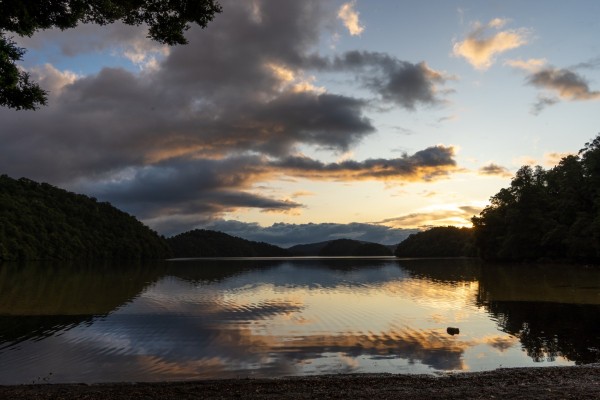Te Urewera describes the large forested mountainous area surrounding and to the north of lakes Waikaremoana and Waikareiti. The stunning natural wilderness is the homeland of Ngāi Tūhoe. At Te Wharehou o Waikaremoana at Aniwaniwa you can learn about Ngāi Tūhoe and the significance of Te Urewera to the tāngata whenua (the people of the land).
The walk to Lake Waikareiti begins near the bridge over Aniwaniwa Stream at Aniwaniwa. A well-graded wide track leads to the day shelter at the southern end of Lake Waikareiti, near the lake outlet. You will reach the shelter after about an hour of walking, and after gaining about 300m altitude. The shelter was opened in May 2014, built in a delightful location. Take a picnic morning tea or lunch and make this your destination, or plan an overnight adventure to stay at Sandy Bay Hut at the north-eastern end of the lake.
Hut bookings can be made, and hut fees paid, through this website, where you will also find information about other day walks nearby. Department of Conservation Lake Waikaremoana Great Walk
Several aluminium row-boats are stored just above lake level at the day shelter. The row-boats can be hired from Te Wharehou o Waikaremoana, Te Urewera Visitor Centre at Aniwaniwa, for a day trip, fishing, or for transport to Sandy Bay Hut for an overnight stay. The high-sided boats can carry five people with gear, and have two sets of rowlocks. These days, a personal locator beacon is hired along with the dinghy, oars and life jackets. Kayaks or outboard motors are not permitted to be carried to Lake Waikareiti because it is one of the few lakes in Aotearoa New Zealand without introduced lake weed. For an overnight stay, choose a settled couple of days because a south-westerly blowing up the lake can create hazardous conditions to row back to the Waikareiti day shelter. Rowing is a great option to transport a family of young children for an overnight stay, or to just enjoy rowing around the lake edge for an hour or two.
From the day shelter, the track around the lake edge is a well-marked tramping track, and easy to follow. Initially it follows the lake edge, then climbs over low ridges further away from the edge. Small sandy beaches overhung by trees provide attractive rest stops.
Sandy Bay, at Lake Waikareiti’s northeastern end, is a shallow bay with white sand. Beech and broadleaved trees overhang the water, with flax and grasses fringing the lake edge.

History of the trail
While the larger Lake Waikaremoana is a landslide-dammed lake, formed about 2000 years ago when a landslide dammed Waikaretaheke River, Lake Waikareiti is a “landslide pond”. A separate much larger landslide occurred on the northeast side of Lake Waikaremoana about 15,000 years ago, and Lake Waikareiti is the largest of the ponds filling hollows within this landslide debris. The lake has six islands, which are really mounds from the old landslide debris, and one, Rahui, encloses its own lake.
Te Urewera was the first natural feature to be recognised in New Zealand law as a legal entity in its own right. The Te Urewera Act 2014 established that Te Urewera is no longer Crown land and ceased to be a national park. Te Urewera Act 2014 The purpose of this Act is to establish and preserve in perpetuity a legal identity and protected status for Te Urewera for its intrinsic worth, its distinctive natural and cultural values, the integrity of those values, and for its national importance, and in particular to:
- strengthen and maintain the connections between Tūhoe and Te Urewera
- preserve as far as possible the natural features and beauty of Te Urewera, the integrity of its indigenous ecological systems and biodiversity, and its historical and cultural heritage
- provide for Te Urewera as a place for public use and enjoyment, for recreation, learning and spiritual reflection, and as an inspiration for all.
Tips & Logistics
Toilets are at the Lake Waikareiti day shelter, Te Wharehou o Waikaremoana, and at the Lake Waikaremoana Holiday Park at Aniwaniwa.
Te Wharehou o Waikaremoana has pamphlets about other options for walks nearby.
Find out everything you need to plan for this track on Plan My Walk